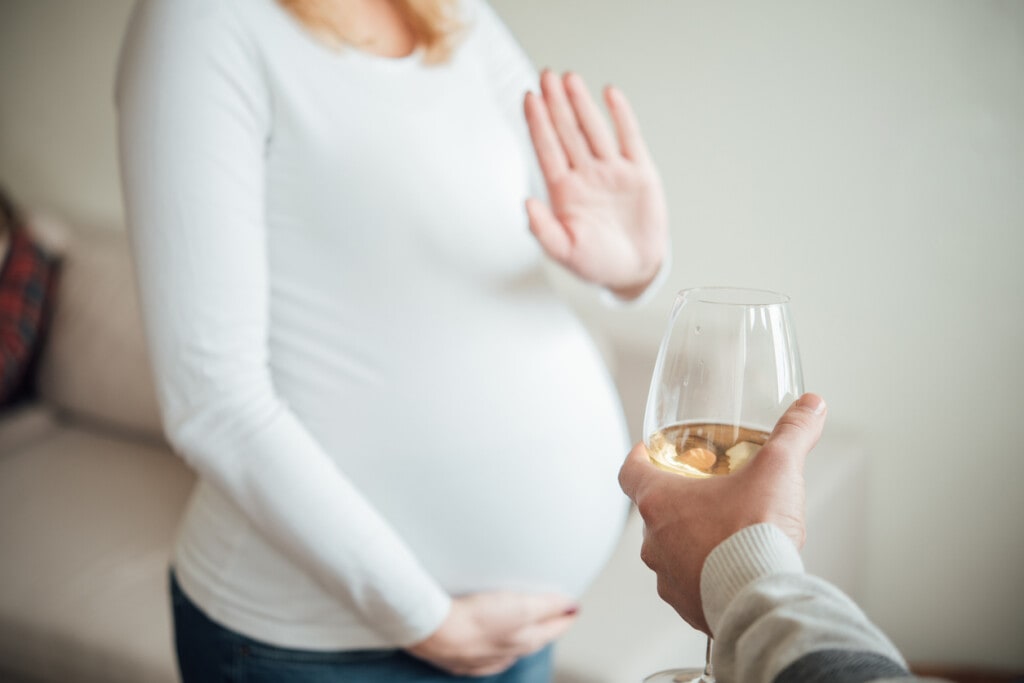When you discover the exciting news you’re expecting, you also learn the lengthy list of don’ts for the remaining nine months.1 Don’t eat raw fish and deli meats or unpasteurized milk products. Don’t drink much caffeine and don’t smoke. Studies show how consuming these products can negatively affect a developing fetus and expectant moms are on board with the guidance. But one guideline still isn’t wholly accepted worldwide: drinking alcohol during pregnancy.
Medical Community: Don’t Drink Alcohol During Pregnancy
Medical professionals and public health organizations worldwide consensus is that moms-to-be should abstain entirely from drinking alcohol mainly because there is no known safe amount of alcohol consumption during pregnancy. Some countries also mandate health warning labels on alcoholic beverages.2
Despite these recommendations and the alarming global toll of infants born with fetal alcohol syndrome (FAS) — a condition that affects infants exposed to alcohol during gestation — recent surveys revealed pregnant women are still enjoying an occasional glass of wine.3
According to The Lancet Global Health, between 1984 and 2014 about 9.8% of women worldwide reported having a drink while pregnant.3 In 2017, the Journal of the Australian College of Midwives published its survey findings, revealing that close to 16% of European women admitted to drinking throughout their pregnancy.4
What Is FAS and How Does It Affect Babies?
Fetal alcohol syndrome is a disabling disease under fetal alcohol spectrum disorder (FASD).5 As the most severe condition under the spectrum, FAS is caused by alcohol exposure during a mom’s pregnancy.
Since alcohol is considered a “teratogen,” a substance that interrupts the normal development of a fetus or embryo, the symptoms of FAS may vary among babies.6 Common symptoms may include problems with an infant’s central nervous system and trouble with learning, memory, attention span, communication, vision, or hearing.5
Physical defects can also occur from FAS, including:6
- Deformed facial features, such as a very thin upper lip, a short, upturned nose, small eyes, and a smooth skin surface between the nose and upper lip
- Deformed joints, limbs, and fingers
- Slow growth before and after birth
- Small head and brain size
- Heart defects
- Issues with kidneys and bones
Each year, one in every 67 women gives birth to an infant suffering from FAS worldwide.3 This means that 119,000 children are typically born with the condition every year, with the highest prevalence of FAS in Belarus, Italy, Ireland, Croatia, and South Africa.
Long History of Alcohol Consumption
Our human ancestors began developing an affinity for alcohol about 10 million years ago by eating fermented fruit, so we could one day digest and enjoy wine.7 By 4,000 BC, alcohol consumption played a central role in most human cultures — China developed its fermented beverage, the people in the South Caucasus learned to make wine, and the Incas brewed their beer from purple corn.8,9,10
As drinking became more prevalent and various civilizations adopted their own cultures and customs, social norms also developed. Today, it’s common to drink during social events for fun, but it’s considered unhealthy to do so alone and during the early hours of the day. It’s acceptable to drink at a bar, club, or home, but it’s frowned upon in public.
The legal drinking age is government regulated in every country. Throughout most of Europe and South America, the legal age is 18. In the U.S., it’s 21, and in some areas in India, it’s as high as 25. But social norms surrounding alcohol vary even more. For instance, in France, most parents won’t bat an eye if their teen has a glass of wine or beer at the dinner table.11,12
Alcohol During Pregnancy Was Once Considered Safe
Drinking while pregnant didn’t initially raise eyebrows. For most of the 20th century, alcohol consumption was considered safe for pregnant moms, and the risks we know today of fetal alcohol exposure were not yet studied.13
In the 1970s, parents began to understand the dangers of alcohol. In 1973, the term fetal alcohol syndrome was coined, and the symptoms associated with the condition were published for the first time in The Lancet.14 Four years later, the U.S.’ newly established National Institute on Alcohol Abuse and Alcoholism issued the first government healthy advisory on alcohol and pregnancy.13
By 1988, the U.S. passed the Alcoholic Beverage Labeling Act, making it the first to legislate pregnancy health warning labels on alcoholic beverages.15 Although there is more public knowledge of the adverse effects of alcohol use during pregnancy, some parts of the world continue to struggle with shifting women’s perspectives.
Top Countries With High Reports of Alcohol Use During Pregnancy
From the American College of Obstetricians and Gynecologists and the U.S. Centers for Disease Control and Prevention to the World Health Organization, the key medical guideline is no level of alcohol is safe for unborn babies. Although scientific research has shown the negative health outcomes from prenatal alcohol exposure, there are still several countries where women continue to drink.16,17,18
A study conducted between 2011 and 2012 in Europe and published in 2017 in Women and Birth, the official journal of the Australian College of Midwives, found that the U.K., Russia, and Switzerland had the highest rate of alcohol consumption during pregnancy. Of those women who consumed alcohol during pregnancy, 39% stated they drank at least one “unit” per month.4
Within that same year, The Lancet Global Health published its international findings, revealing that almost 10% of women drank while pregnant.3 The top five countries with the highest prevalence of alcohol use during pregnancy were Russia, the UK, Denmark, Belarus, and Ireland — all of which belong to the WHO European Region.
On the other hand, regions marked by high abstinence rates, such as Oman, United Arab Emirates, Saudi Arabia, Qatar, and Kuwait, reported the lowest prevalence of alcohol use during pregnancy.3
Advisories on Alcohol During Pregnancy Are Inconsistent
Although Europe promotes government-regulated drinking guidelines, only select countries must include pregnancy warning labels on alcohol products.20,21 Women may be ignoring guidelines due to the lack of consistent advisories.
Five years after France introduced pregnancy-related health warning labels, 66% of women and 77% of all drinkers surveyed during pregnancy or postpartum stated they were aware of the labels. However, about 99% interpreted the warnings as a suggestion to abstain from drinking during pregnancy.22
Another survey conducted in Australia found that women felt abstinence was a burden and “talked about the importance of alcohol to their social lives as a reason for continuing to drink.”23 They also viewed drinking small amounts of alcohol as a low-risk activity.
As of May 2022, the WHO recommended the adoption of a global action plan to reduce the use of alcohol, which includes prevention efforts for drinking during pregnancy and FAS disorders.19
For moms who are expecting and have received conflicting advice from a friend of a friend’s cousin twice removed, remember the global rule of thumb: abstinence from alcohol during your pregnancy is the best way to keep your little one healthy and safe. If you have any concerns or questions, contact your health professional, who can provide additional guidance.









